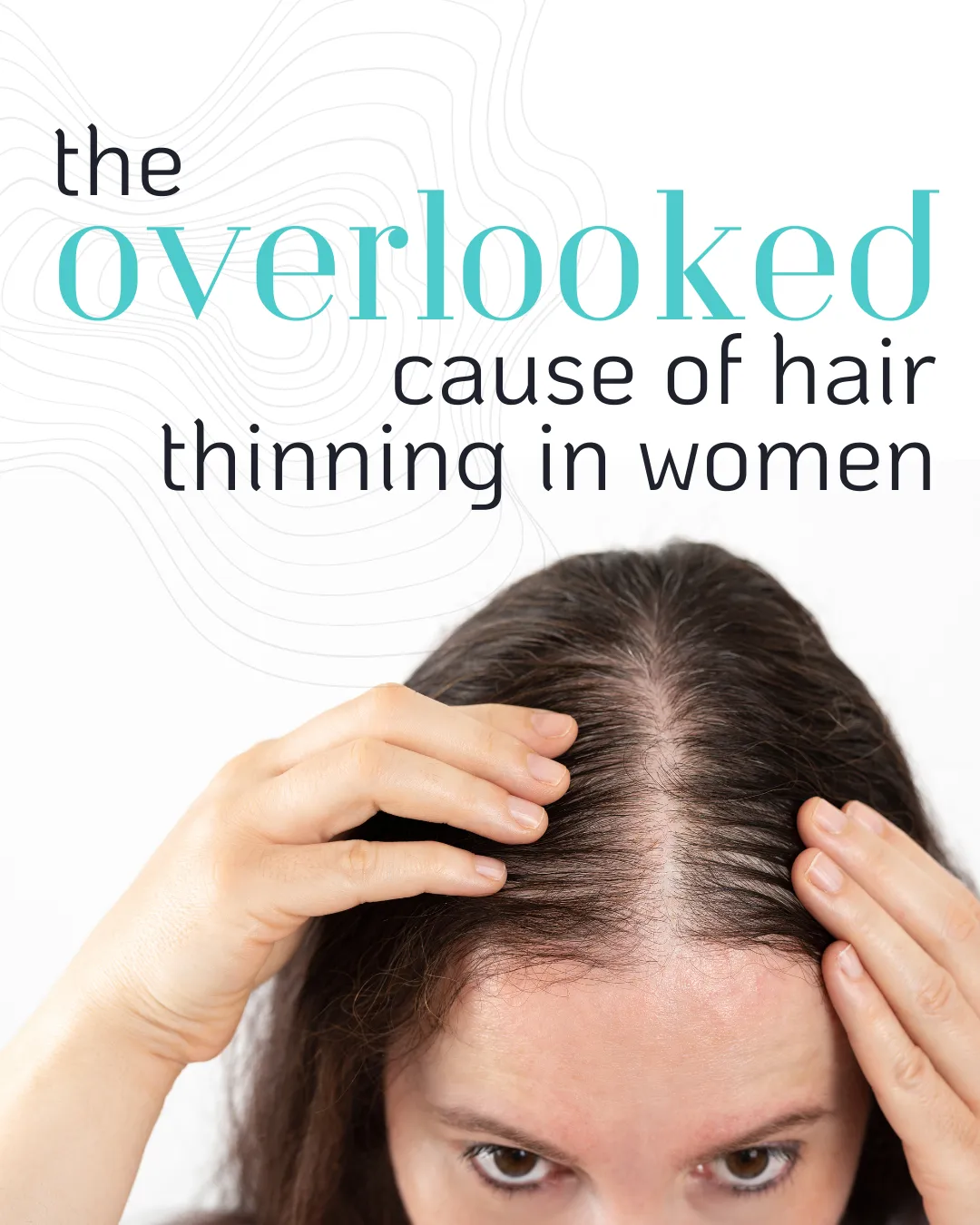
The Overlooked Trio Behind Women's Hair Thinning
Why Your Hair Is Thinning—and What Your Body Might Be Telling You
You’ve noticed it: your ponytail feels thinner, your brush fills up faster, and your part looks wider than it did last year. For many women, hair thinning sneaks in slowly and is often dismissed as “just stress” or “part of getting older.”
But here’s the truth: thinning hair isn’t always about age. More often, it’s your body waving a red flag that something deeper is off.

The Overlooked Root Causes of Hair Thinning
Hair growth depends on a delicate balance of nutrients, hormones, and metabolism. When that balance shifts, your scalp often shows it first. Yet, conventional care too often stops at a quick glance, a multivitamin suggestion, or a “don’t worry, it’s normal.”
What gets missed? Three of the most common—yet under-recognized—causes:
Low iron stores
Thyroid imbalances
Androgen (hormone) excess
1. Iron Deficiency: Fuel for Your Follicles
Iron isn’t just about preventing anemia—it’s critical for hair follicle health. Without enough, the growth cycle gets disrupted, leading to diffuse thinning and increased shedding.
Here’s the catch: you can have “normal” iron labs but still not enough to support hair growth. Research suggests ferritin (your iron storage marker) should be above 70 ng/mL for healthy hair.
Why iron drops: heavy periods, low intake of iron-rich foods, GI issues (like celiac or IBD), frequent blood donation, low stomach acid, or even endurance exercise.
The fix: address the cause, restore iron through diet or supplements, and give it 3–6 months for results to show up in your hair.
2. Thyroid Dysfunction: The Engine Regulator
If iron fuels hair follicles, thyroid hormones set the pace. Too little (hypothyroidism) or too much (hyperthyroidism) can both cause shedding, often across the entire scalp.
Other thyroid clues? Fatigue, weight changes, mood swings, constipation or diarrhea, menstrual changes, and thinning of the outer eyebrows.
The problem: many doctors only run a TSH test, which can miss subtle dysfunction. A full panel (free T4, free T3, reverse T3, and thyroid antibodies) is essential for uncovering hidden imbalances.
3. Androgen Excess: When Hormones Hijack Hair
Androgens (like testosterone and DHT) aren’t just male hormones—women need them too. But when levels climb or follicles become sensitive, the result is female pattern hair loss: a widening part, thinning on the crown, and gradual follicle shrinkage.
This can be linked to PCOS, insulin resistance, obesity, or adrenal/ovarian conditions. Other telltale signs include acne, oily skin, excess facial or body hair, and irregular periods.
Why Doctors Often Miss It
Symptoms overlap with stress, aging, or busy life.
Labs look “normal” when only minimal testing is done.
Fragmented care—different doctors treat different symptoms without connecting the dots.
Time constraints in short visits mean root causes go unexplored.
A Functional Medicine Approach
From a functional medicine perspective, hair thinning isn’t the problem—it’s the symptom. The real question: why is this happening?
That means going beyond “take a vitamin” and digging deeper:
✅ A full health history (menstrual cycles, digestion, stress, energy, etc.)
✅ Comprehensive labs (ferritin, full thyroid panel, androgens)
✅ Finding why labs are off (poor absorption? heavy bleeding? insulin resistance?)
✅ Targeted nutrition and supplements
✅ Lifestyle support (stress, sleep, metabolic health)
Bottom Line
Hair thinning isn’t just about vanity. It’s your body’s way of saying something’s out of balance. If you’ve been told “your labs are fine,” but your hair tells a different story, it may be time to look deeper.
References
Kantor J, Kessler LJ, Brooks DG, Cotsarelis G. Decreased serum ferritin is associated with alopecia in women. J Invest Dermatol. 2003;121(5):985–988. doi:10.1046/j.1523-1747.2003.12540.x
Rushton DH. Nutritional factors and hair loss. Clin Exp Dermatol. 2002;27(5):396–404. doi:10.1046/j.1365-2230.2002.01076.x
Sinclair RD. Diffuse hair loss. Int J Dermatol. 2015;54(10):1112–1124. doi:10.1111/ijd.12822
Bertoli MJ, Sadoughifar R, Schwartz RA, Lotti TM, Janniger CK. Female pattern hair loss: A comprehensive review. Dermatol Ther. 2020;33(6):e14055. doi:10.1111/dth.14055
Carmina E, Azziz R, Bergfeld W, Futterweit W, Huddleston H, Lobo R, Yildiz BO. Female pattern hair loss and androgen excess: A report from the multidisciplinary androgen excess and PCOS committee. J Clin Endocrinol Metab. 2019;104(7):2875–2883. doi:10.1210/jc.2019-00221
Ho CH, Sood T, Zito PM. Androgenetic Alopecia. In: StatPearls [Internet]. Treasure Island, FL: StatPearls Publishing; 2024. Available from: https://www.ncbi.nlm.nih.gov/books/NBK430924/
